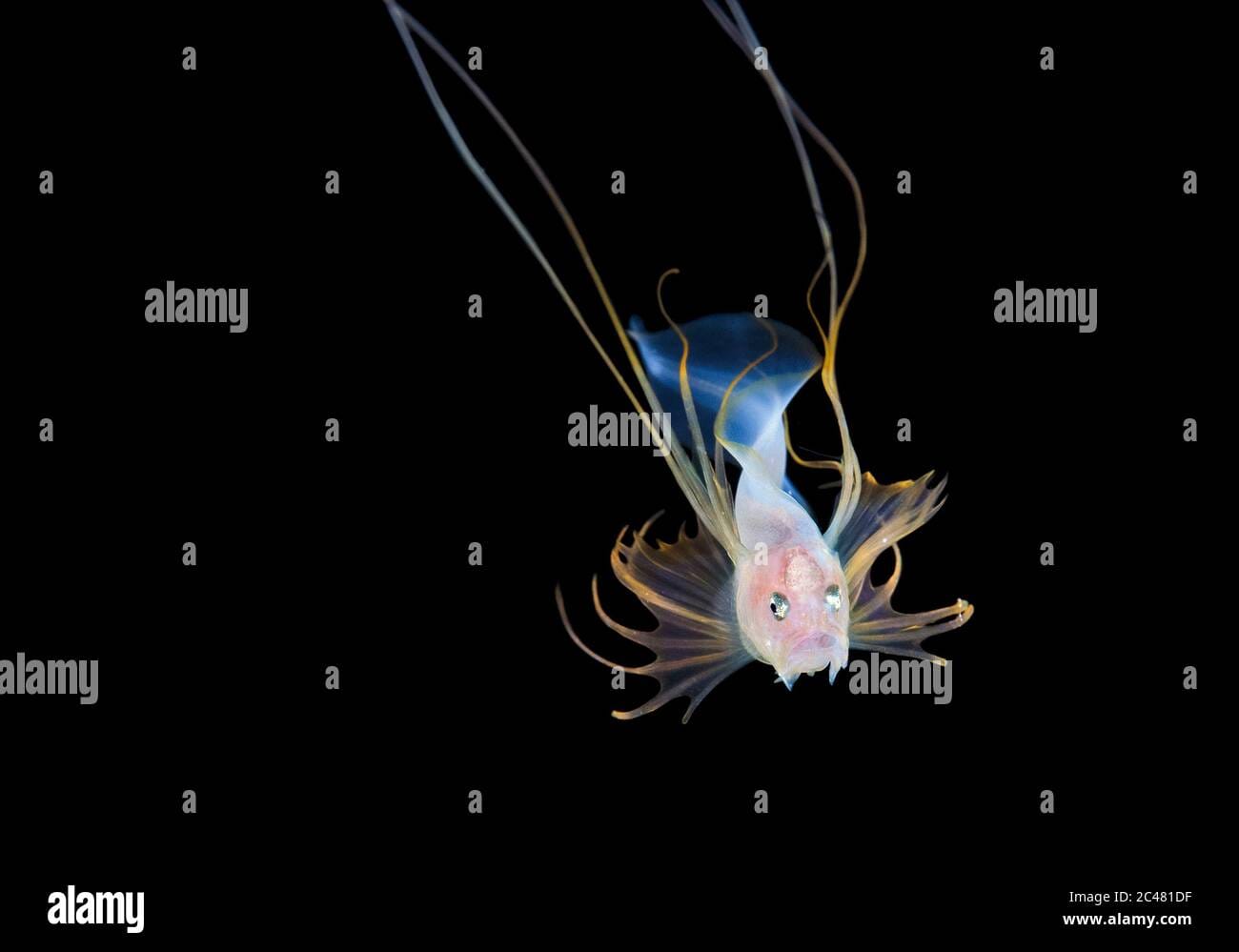Meet the bony-eared assfish, a creature seemingly plucked straight from a cartoon! Its peculiar appearance suggests Mother Nature has a unique sense of humor. Let’s journey into the inky depths of the ocean to uncover the secrets of this bizarre fish, from its peculiar name to its remarkable adaptations. Prepare to be amazed by its resilience and the fascinating world it inhabits in the ocean’s shadows.
A Fish Weirder Than Its Name
The name “bony-eared assfish” might not evoke images of a graceful deep-sea denizen, but this fish is far more intriguing than its name suggests. Inhabiting ocean depths where sunlight barely penetrates, the bony-eared assfish resembles something out of science fiction, and scientists are only beginning to unravel its mysteries.
Imagine a bulbous, almost comically large head perched atop a body that tapers like a tadpole’s tail. Add some bony plates around its head, resembling misplaced ears, and you have yourself a bony-eared assfish. While not a contender for any beauty awards, appearances aren’t everything in the deep, dark ocean!
So, what’s behind the name? Some speculate that its flesh resembles that of a donkey (the source of this comparison remains a mystery). However, the name pales in comparison to the fish’s most fascinating feature: its incredibly small brain. Proportionally, it’s one of the smallest in the fish world, sparking debate among scientists about the brainpower needed to survive in the deep sea’s harsh conditions of scarce food and intense pressure.
Despite its diminutive brain, the bony-eared assfish is a surprisingly successful predator. Its large mouth opens incredibly wide, and its stomach expands to accommodate prey even larger than itself—a testament to the extraordinary adaptations life develops in the most extreme environments.
The bony-eared assfish might not be the most aesthetically pleasing fish, but it exemplifies the importance of protecting our oceans and the diverse, often strange, creatures that call them home. It serves as a reminder of the vast knowledge we have yet to uncover about the deep sea and its inhabitants. And, let’s be honest, any fish with such a peculiar name deserves a bit of respect, wouldn’t you say?
The Mystery of the Miniature Brain
Speaking of brains, the bony-eared assfish’s brain is a source of much fascination. This fish is renowned for its exceptionally small brain, even when compared to other deep-sea creatures. Research has shown that the weight of their brains can vary significantly, with some assfish possessing brains weighing less than 30 milligrams—an almost incomprehensibly small size, lighter than a grain of rice.
Why such a small brain? Life in the deep sea is a constant struggle for survival. Darkness, frigid temperatures, and scarce food resources demand energy conservation above all else. A large brain requires significant energy, so a smaller brain might be an evolutionary advantage in this challenging environment. Think of it as trading a gas-guzzling SUV for a fuel-efficient compact car—both will get you to your destination, but one is far more economical, especially when resources are scarce.
However, a small brain doesn’t necessarily equate to low intelligence. Scientists believe the brain-to-body ratio is a much more accurate indicator of cognitive ability, providing insight into an animal’s brainpower relative to its size.
While research on the bony-eared assfish is ongoing, one thing is clear: this fish is remarkably well-suited to its environment. It navigates the darkness, locates food, and reproduces, all with a brain specifically equipped for its deep-sea lifestyle.
Scientists are still working to understand the factors influencing brain size in these fish. Does behavior play a role? What about the specific challenges of their environment? These are just a few questions researchers hope to answer in the future. The bony-eared assfish, with its extraordinarily small brain, reminds us that intelligence manifests in many forms, each uniquely adapted for survival.
The Smallest Brain in the Vertebrate World?
Remember the adage, “Don’t judge a book by its cover?” This holds particularly true for the bony-eared assfish. Despite its unfortunate name, this creature boasts a remarkable title: it’s believed to have the smallest brain-to-body ratio of any known vertebrate.
To grasp the tininess of this fish’s brain, let’s compare it to our own. The human brain accounts for approximately 2% of our total body weight. The bony-eared assfish takes this to another level entirely. Its brain makes up a minuscule 0.0005% of its body weight—akin to finding a single grain of sand on a vast beach.
Why such a small brain? The bony-eared assfish inhabits the deep ocean, a world of perpetual darkness and limited food. In such a harsh environment, energy efficiency is paramount. Brains, for all their wonders, are energy-intensive organs. Over millions of years, the bony-eared assfish has adapted by essentially downsizing its brain, trading brainpower for energy conservation in this challenging habitat.
How does it survive with such a tiny brain? This is where those “bony ears” come into play. They aren’t ears at all but highly sensitive sensory organs that help the fish navigate the pitch-black depths and locate food. Think of them as a built-in sonar system, allowing the bony-eared assfish to “see” in the absence of light.
The bony-eared assfish is a testament to the power of evolution. Its incredibly small brain highlights a fascinating aspect of survival: sometimes, less is more. In the deep ocean, where resources are scarce, a smaller brain is not a disadvantage but a key to survival.
Acanthonus armatus: The Name Behind the Fish
We’ve established that the bony-eared assfish has an unusual common name. But have you ever wondered about its formal scientific name? Let’s delve into the Latin and uncover the story behind its official title.
This peculiar fish is formally known as Acanthonus armatus. While it might sound intimidating, it’s quite descriptive.
The first part, Acanthonus, originates from the ancient Greek word “akantha,” meaning “prickly” or “thorn.” This makes perfect sense considering the bony protrusions near its gills, which resemble, you guessed it, bony ears.
The second part, armatus, comes from Latin and means “armed.” This refers to the fish’s armor-like exterior, with bony plates covering its body and sharp spines on its nose and gills—talk about being well-protected!
As for the common name “assfish”? Its origin is less clear. Some believe it’s because the fish’s flesh resembles donkey meat, while others posit it’s merely a whimsical name given to a strange-looking creature. Whatever the reason, “assfish” undoubtedly adds to its charm.
The bony-eared assfish, with its scientific name Acanthonus armatus, remains an intriguing inhabitant of the deep. From its prickly “ears” to its armored exterior, this fish embodies the weird and wonderful diversity of our oceans.
Don’t forget to explore the other fascinating creatures in our marine world, like the bowmouth guitarfish and the mysteries surrounding the enigmatic Boynton Canyon vortex.












